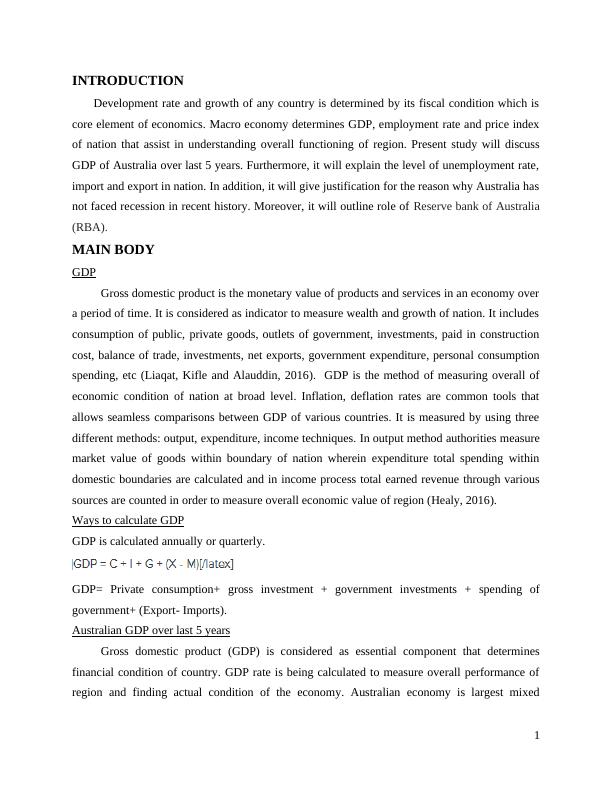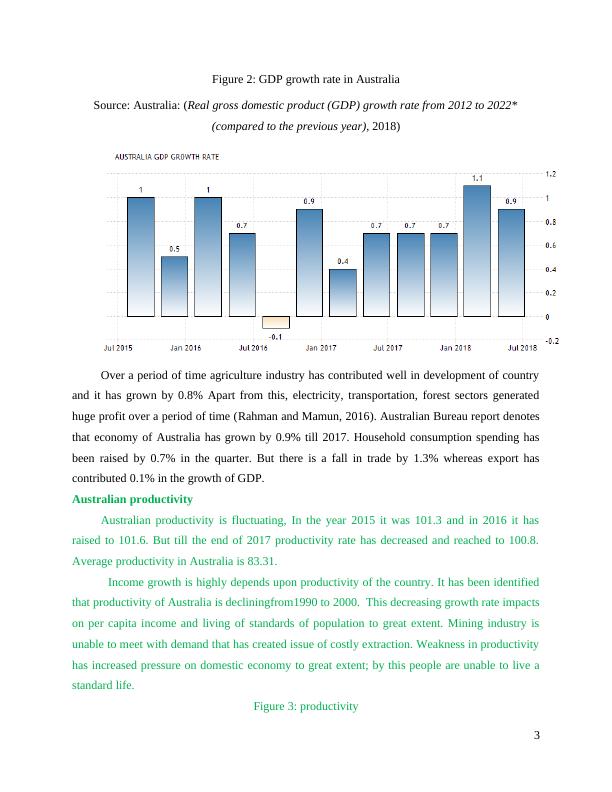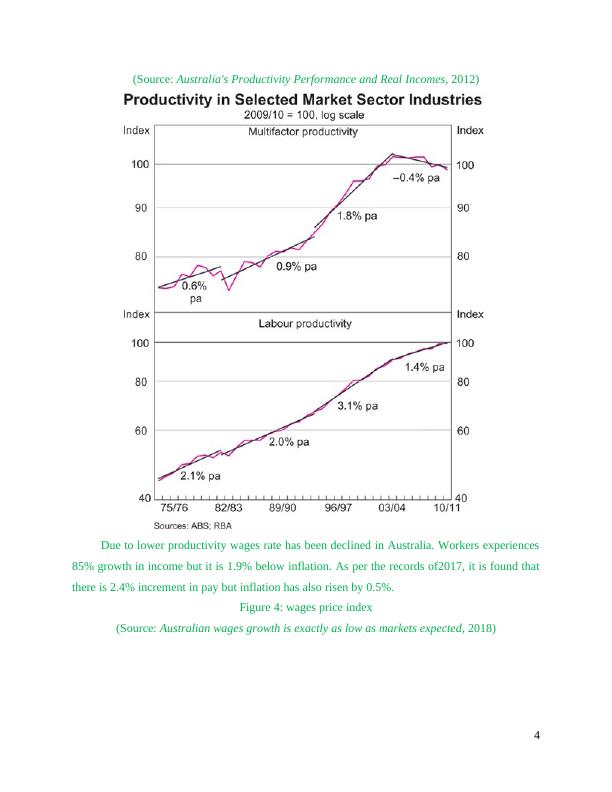Foreign Investment in Australia on Economic PDF
21 Pages4053 Words448 Views
Added on 2020-12-18
Foreign Investment in Australia on Economic PDF
Added on 2020-12-18
ShareRelated Documents
ECONOMIC

TABLE OF CONTENTSINTRODUCTION...........................................................................................................................1MAIN BODY..................................................................................................................................1GDP.............................................................................................................................................1Ways to calculate GDP................................................................................................................1Australian GDP over last 5 years.................................................................................................1Level of unemployment rate in Australia....................................................................................3Level of exports...........................................................................................................................5Level of import............................................................................................................................8Inflation rate and foreign investment in Australia.......................................................................9Nature of assets such as having market shares..........................................................................12Reasons, why Australia is not facing recession in recent history..............................................13Role of RBA (Reserve bank of Australia).................................................................................13Fiscal policy of Government for economicgrowth...................................................................14CONCLUSION..............................................................................................................................15REFERENCES..............................................................................................................................16

INTRODUCTIONDevelopment rate and growth of any country is determined by its fiscal condition which iscore element of economics. Macro economy determines GDP, employment rate and price indexof nation that assist in understanding overall functioning of region. Present study will discussGDP of Australia over last 5 years. Furthermore, it will explain the level of unemployment rate,import and export in nation. In addition, it will give justification for the reason why Australia hasnot faced recession in recent history. Moreover, it will outline role of Reserve bank of Australia(RBA).MAIN BODYGDPGross domestic product is the monetary value of products and services in an economy overa period of time. It is considered as indicator to measure wealth and growth of nation. It includesconsumption of public, private goods, outlets of government, investments, paid in constructioncost, balance of trade, investments, net exports, government expenditure, personal consumptionspending, etc (Liaqat, Kifle and Alauddin, 2016). GDP is the method of measuring overall ofeconomic condition of nation at broad level. Inflation, deflation rates are common tools thatallows seamless comparisons between GDP of various countries. It is measured by using threedifferent methods: output, expenditure, income techniques. In output method authorities measuremarket value of goods within boundary of nation wherein expenditure total spending withindomestic boundaries are calculated and in income process total earned revenue through varioussources are counted in order to measure overall economic value of region (Healy, 2016).Ways to calculate GDPGDP is calculated annually or quarterly. GDP= Private consumption+ gross investment + government investments + spending ofgovernment+ (Export- Imports).Australian GDP over last 5 yearsGross domestic product (GDP) is considered as essential component that determinesfinancial condition of country. GDP rate is being calculated to measure overall performance ofregion and finding actual condition of the economy. Australian economy is largest mixed1

economies across the globe (Jiang and et.al, 2017). In the year 2010 GDP rate of Australia was2.6% and in the year 2012 it has reached to 3.9%. However, after decline country faced issuesand till the end of 2013 its GDP rate declined to 2.16%. Government took various actions toimprove fiscal condition of nation and have made changes in its policies. All these things helpedin improving GDP, in the year 2015 which led to increase up to 2.47%. Australian GDP is highly fluctuating and due to changes in economic elements price ofproducts and services get changes. All these things affect GDP rate of region to great extent(Wong, 2017). In the year 2016 GDP rate of Australia was 2.65%, in 2018 it was recorded2.96%. It is expected that till the end of 2022 Australian GDP will reach to 2.61%Figure 1: GDP of AustraliaSource: (Australia GDP Growth Rate, 2018)2

Figure 2: GDP growth rate in AustraliaSource: Australia: (Real gross domestic product (GDP) growth rate from 2012 to 2022*(compared to the previous year), 2018)Over a period of time agriculture industry has contributed well in development of countryand it has grown by 0.8% Apart from this, electricity, transportation, forest sectors generatedhuge profit over a period of time (Rahman and Mamun, 2016). Australian Bureau report denotesthat economy of Australia has grown by 0.9% till 2017. Household consumption spending hasbeen raised by 0.7% in the quarter. But there is a fall in trade by 1.3% whereas export hascontributed 0.1% in the growth of GDP.Australian productivityAustralian productivity is fluctuating, In the year 2015 it was 101.3 and in 2016 it hasraised to 101.6. But till the end of 2017 productivity rate has decreased and reached to 100.8.Average productivity in Australia is 83.31. Income growth is highly depends upon productivity of the country. It has been identifiedthat productivity of Australia is decliningfrom1990 to 2000. This decreasing growth rate impactson per capita income and living of standards of population to great extent. Mining industry isunable to meet with demand that has created issue of costly extraction. Weakness in productivityhas increased pressure on domestic economy to great extent; by this people are unable to live astandard life.Figure 3: productivity3

(Source: Australia's Productivity Performance and Real Incomes, 2012)Due to lower productivity wages rate has been declined in Australia. Workers experiences85% growth in income but it is 1.9% below inflation. As per the records of2017, it is found thatthere is 2.4% increment in pay but inflation has also risen by 0.5%. Figure 4: wages price index(Source: Australian wages growth is exactly as low as markets expected, 2018)4

End of preview
Want to access all the pages? Upload your documents or become a member.
Related Documents
Applied Economics: Economic Growth Trend and Fiscal-Monetary Policy in Australialg...
|6
|1021
|398
Impact of Bushfires on Australia's GDP and Unemployment Ratelg...
|7
|1726
|36
Economic Growth of Australia: Analysis of Last Five Yearslg...
|16
|2882
|270
Macroeconomic Analysis of Australia using Aggregate Expenditure Modellg...
|13
|2403
|346
Economic Impact of Coronavirus Outbreak.lg...
|5
|1483
|51
Impact of Low Real Wage Growth on the AD AS Curvelg...
|13
|2684
|63
